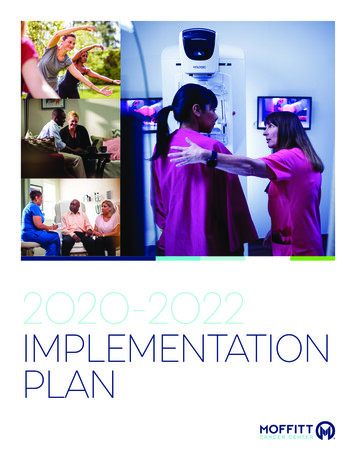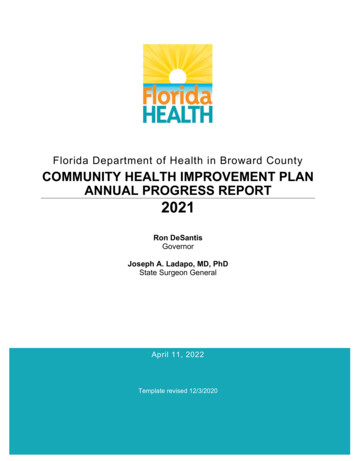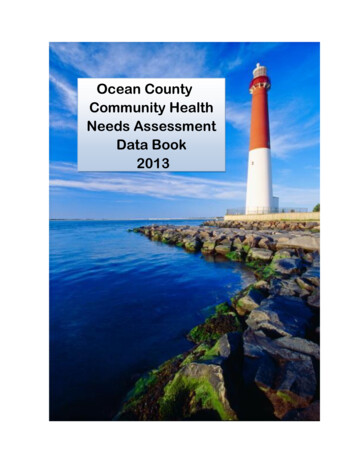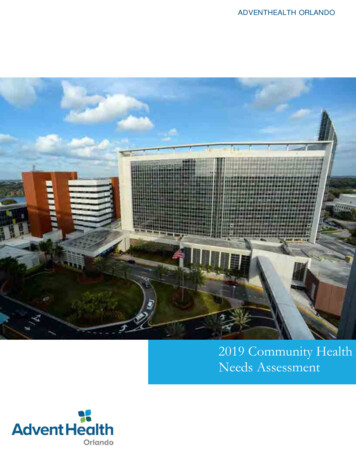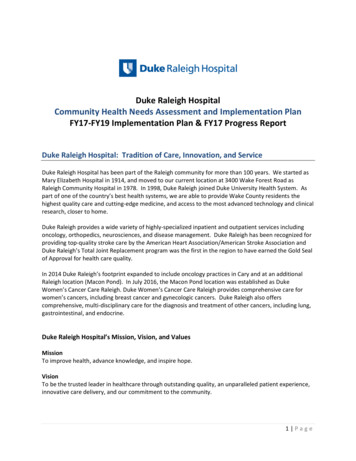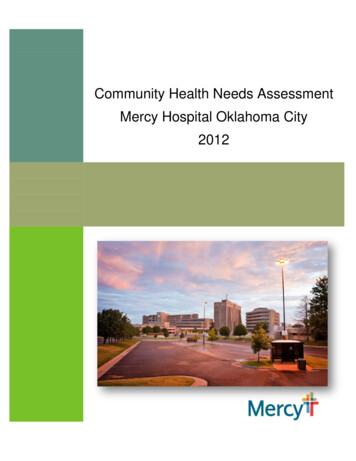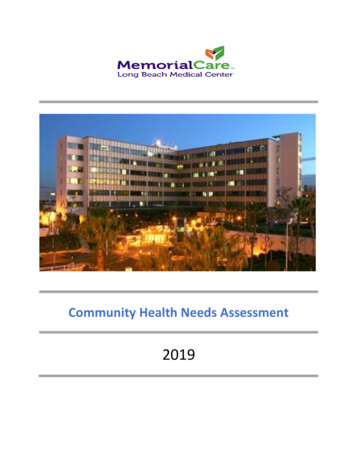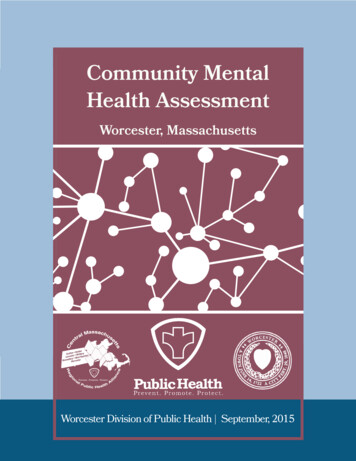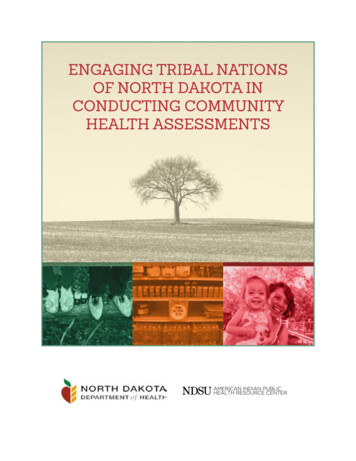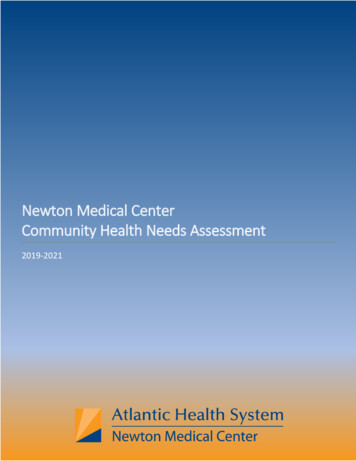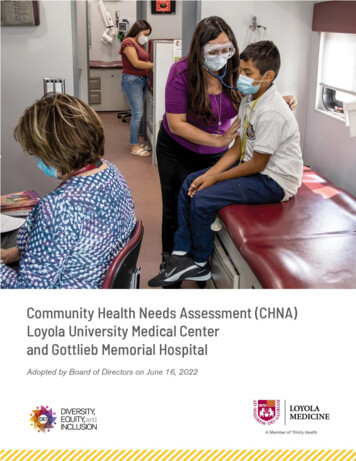
Transcription
Community Health Needs Assessment – Loyola University Medical Center and Gottlieb Memorial Hospital – 2
Community Health Needs Assessment (CHNA)Loyola University Medical Center and Gottlieb Memorial HospitalTABLE OF CONTENTSIntroduction to Loyola Medicine . .4Alliance for Health Equity . .5Community Engagement in CHNA 5CHNA Priorities . 9Communities Served . 10Community Input on Priorities . .12Mortality . .14Morbidity . 16Social and Structural Influencers of Health .17Mental Health and Substance Use Disorders .19Access to Healthcare 21Updates on Implementation Activities from Previous CHNA . .22Countywide Alliance for Health Equity CHNA . . Community Health Needs Assessment – Loyola University Medical Center and Gottlieb Memorial Hospital – 3
INTRODUCTION TO LOYOLA MEDICINEFor more information or to comment on this Community Health Needs Assessment (CHNA):Email hs.orgWebsite benefitPaper copies are available upon request.Loyola Medicine is a not-for-profit, mission-based, Catholic organization consisting of three hospitalslocated in the western suburbs of Chicago: Loyola University Medical Center (LUMC) in Maywood,Gottlieb Memorial Hospital (GMH) in Melrose Park, and MacNeal Hospital in Berwyn. All three hospitalsare members of Trinity Health, a national Catholic not-for-profit health system. Trinity Health is a familyof 115,000 colleagues and nearly 26,000 physicians and clinicians caring for diverse communities across25 states. Nationally recognized for care and experience, the Trinity Health system includes 88 hospitals,131 continuing care locations, the second largest Program for All-Inclusive Care of the Elderly (PACE) inthe country, 125 urgent care locations and many other health and well-being services. Based in Livonia,Michigan, Trinity Health’s annual operating revenue is 20.2 billion, with 1.2 billion returned to itscommunities in the form of charity care and other community benefit programs.Loyola University Medical Center (LUMC) is a 547-bed academic medical center that providescomprehensive services, including a center for heart and vascular medicine, a Level 1 trauma center,Illinois’s largest burn center, a cancer center, neurosciences, orthopaedic surgery, digestive health, atransplant center, a children’s hospital, immediate care, telemedicine, inpatient and acuterehabilitation, and home health care. LUMC discharged 20,370 patients in fiscal year 2021 and received36,470 emergency room visits. LUMC also includes one of the region’s largest transplant centers.Gottlieb Memorial Hospital (GMH) is a 247-bed hospital that conducts cancer research and providesservices in metabolic surgery and bariatric care, transitional care, geriatric behavioral health and a childdaycare center. In fiscal year 2021, GMH discharged 5,570 patients and received 25,660 emergencyvisits (MacNeal Hospital is a 374-bed teaching hospital. MacNeal has its own Community Health NeedsAssessment report on the Loyola Medicine website).Loyola Medicine also trains the next generation of medical caregivers through its affiliation with LoyolaUniversity Chicago’s Stritch School of Medicine and Marcella Niehoff School of Nursing. Loyola’s otheracademic partners include Edward Hines Jr. Veterans Hospital, Loyola University Chicago Health SciencesDivision, and Loyola University Chicago Center for Translational Research & Education. In the 2021 fiscalyear, Loyola Medicine invested 71,854,149 into support for health education and research.MISSION AND CORE VALUESAs members of Trinity Health, Loyola University Medical Center and Gottlieb Memorial Hospital arecommitted to Trinity Health’s mission:We, Trinity Health, serve together in the spirit of the Gospel as a compassionate and transforminghealing presence within our communities.Additionally, Loyola Medicine’s core values are:Reverence, Commitment to Those Who are Poor, Safety, Justice, Stewardship, IntegrityCommunity Health Needs Assessment – Loyola University Medical Center and Gottlieb Memorial Hospital – 4
ALLIANCE FOR HEALTH EQUITYThe Alliance for Health Equity is a collaborative of 35 hospitals working with health departments andregional and community-based organizations to improve health equity, wellness, and quality of lifeacross Chicago and Suburban Cook County. The Alliance for Health Equity conducted a collaborativeCommunity Health Needs Assessment (CHNA) between May 2021 and March 2022, during a time thatcommunities across our county, country, and globe have been experiencing profound impacts from theCOVID-19 pandemic. The health, economic, and social impacts of the pandemic are strongly present inwhat we heard from community members and healthcare and public health workers over the course ofthe assessment.Loyola Medicine is a founding member of the Alliance for Health Equity since its launch in 2015.Collaborative Community Health Needs Assessment (CHNA) in Cook County is an important foundationfor the work of the Alliance for Health Equity. The purpose of the Alliance for Health Equity is to improvepopulation and community health by: Promoting health equitySupporting capacity building, shared learning and connecting local initiativesAddressing social and structural determinants of healthDeveloping broad city and county wide initiatives and creating systemsEngaging community partners and working collaboratively with community leadersDeveloping data systems for population health to support shared impact measurement andcommunity assessmentCollaborating on population health policy and advocacyThe 2022 Community Health Needs Assessment is the third collaborative CHNA in Cook County, Illinois.The Illinois Public Health Institute (IPHI) acts as the backbone organization for the Alliance for HealthEquity. The IPHI works closely with the steering committee to design the CHNA to meet regulatoryrequirements under the Affordable Care Act and to ensure close collaboration with the ChicagoDepartment of Public Health (CDPH) and Cook County Department of Public Health (CCDPH) on theircommunity health assessment and community health improvement planning processes. For this CHNA,the Alliance for Health Equity has taken a very intentional approach to build on the previouscollaborative CHNA work (2016, 2019), Healthy Chicago 2025 (2020), and Suburban Cook CountyWePLAN (2022).COMMUNITY AND STAKEHOLDER ENGAGEMENTLoyola Medicine engages community members and stakeholders in the CHNA both through the Alliancefor Health Equity and through hyperlocal partnerships with coalitions and community groups in theMaywood, Melrose Park, and Berwyn-Cicero area.Loyola Medicine and the Alliance for Health Equity prioritizes engagement of community members andcommunity-based organizations as a critical component of assessing and addressing community healthneeds.Community Health Needs Assessment – Loyola University Medical Center and Gottlieb Memorial Hospital – 5
For the 2022 CHNA, community engagement has been particularly crucial for a couple reasons:1. As Loyola Medicine and the Alliance for Health Equity strive to strengthen our work for healthand racial equity, community co-design and engagement in decision making is at the core ofthe work.2. The most up-to-date data and information about health and social well-being and needs comefrom community partners and community members, particularly during the current pandemicwhen conditions on the ground are shifting so fast.Community partners have been involved in the Alliance for Health Equity’s CHNA and ongoingimplementation process in several ways. The Alliance for Health Equity’s methods of communityengagement for the CHNA and implementation strategies include: Gathering input from community residents who are underrepresented in traditional assessmentand implementation planning processes;Partnering with community-based organizations for collection of community input throughsurveys and focus groups;Engaging community-based organizations and community residents as members ofimplementation committees and workgroups;Utilizing the expertise of the members of implementation committees and workgroups inassessment design, data interpretation, and identification of effective implementation strategiesand evaluation metrics;Working with hospital and health department community advisory groups to gather input intothe CHNA and implementation strategies; andPartnering with local coalitions to support and align with existing community-driven efforts.The community-based organizations engaged in the Alliance for Health Equity represent a broad rangeof sectors such as workforce development, housing and homeless services, food access and food justice,community safety, planning and community development, immigrant rights, youth development,community organizing, faith communities, mental health services, substance use services, policy andadvocacy, transportation, older adult services, healthcare services, higher education, and many more.All community partners work with or represent communities that are disproportionately affected byhealth inequities such as communities of color, immigrants, youth, older adults and caregivers, LGBTQ ,individuals experiencing homelessness or housing instability, individuals living with mental illness orsubstance use disorders, individuals with disabilities, veterans and unemployed youth and adults.The Alliance for Health Equity 2021-2022 CHNA process for Cook County relied upon input fromnumerous sources including over 5,200 community input surveys, 43 focus groups, participation fromexisting AHE workgroups and population data collected by health departments. Where necessary andapplicable, existing research provided reliable information in determining county-wide priority healthissues. Loyola Medicine partnered with internal experts and the community coalitions to identifypriorities by considering multiple factors, including health equity goals, community priorities, urgency,feasibility, existing priorities and alignment with the existing work of health departments, otherhospitals and community partners.Throughout the CHNA process, Loyola Medicine partnered with five community-based coalitions—West Cook Coalition, Proviso Partners for Health (PP4H), Proviso Township Ministerial Alliance(PTMAN), Cicero Community Collaborative (CCC), and the Community Alliance of Melrose Park—which comprise community members and providers from the following sectors: healthcare, publicCommunity Health Needs Assessment – Loyola University Medical Center and Gottlieb Memorial Hospital – 6
health, behavioral health, human services, community-based organizations, faith-based organizations,legal services, immigration services, private and public sectors and legislators.Loyola Medicine intentionally structured deeper engagement of local communities during the phase ofprioritizing community health needs. Specifically, we worked with CCC, The Community Alliance ofMelrose Park, PP4H, and PTMAN to host meetings throughout March and April 2022 to review CHNAdata and provide input on priorities. These coalitions will also be involved in the implementationstrategy planning process.COUNTYWIDE CHNA PRIORITIESThrough the 2021-2022 countywide Community Health Needs Assessment (CHNA), the Alliance forHealth Equity identified the following key health needs across Cook County. Addressing social and structural determinants of healthIssues involving social and structural determinants of health include: (1) addressing structuralracism and advancing racial equity, (2) advocating for policies that advance equity and promotephysical and mental wellbeing, (3) working towards conditions that support healthy eating andactive living, (4) shifting power for community engagement in decision-making, (5) economicvitality and workforce development, (6) education and youth development, (7) food security andfood access, (8) housing, transportation, and neighborhood environment and (9) addressingtrauma, violence and social isolation. Improving access to care and community resourcesIssues involving access to care and community resources include: (1) addressing structuralracism and discrimination in healthcare, (2) culturally and linguistically appropriate care, (3) datasystems, (4) emergency and pandemic preparedness, (5) resources, referrals, coordination, andconnection to community-based services, (6) increased timely linkage to appropriate care,including behavioral health and social services, (7) trauma-informed care and (8) workforcedevelopment and support for healthcare, behavioral health, and human services workers. Addressing priority health conditionsChronic conditions; COVID-19; injury, including violence-related injury; maternal and childhealth, including maternal and infant mortality; mental health; and substance use disordersThrough addressing CHNA priorities, the Alliance for Health Equity seeks to increase health equity,increase life expectancy, improve health, improve systems of care, and improve quality of life.Community Health Needs Assessment – Loyola University Medical Center and Gottlieb Memorial Hospital – 7
Figure 1. Alliance for Health Equity – Priority Community Health Needs 2022Community Health Needs Assessment – Loyola University Medical Center and Gottlieb Memorial Hospital – 8
PRIORITY COMMUNITY HEALTH NEEDSFOR LOYOLA UNIVERSITY MEDICAL CENTER AND GOTTLIEB MEMORIAL HOSPITALTo prioritize community health needs, Loyola Medicine partnered with community coalitions to holdthree community meetings in March-April 2022 to review data from the CHNA (community input dataand secondary data). The meetings were hosted by CCC, The Community Alliance of Melrose Park, andPTMAN. Two of the meetings were held virtually, and one was a hybrid meeting with both in-person andvirtual options. After reviewing and discussing data, each community member present at the meetingswas asked to identify and comment on 2-3 priority community health needs. Community members wereencouraged to consider the following factors in prioritizing: size and magnitude of need, priorityidentified by community members in the CHNA, equity and disparities and opportunities to partner. Theidentified priorities were compiled and synthesized by the Loyola Medicine community health and wellbeing and Alliance for Health Equity teams. The priority community health needs are ranked belowbased on community partners’ input:Priority Community Health Needs –– Loyola University Medical Center and Gottlieb MemorialHospital1. Mental Healtha2. Social and Structural Influencers of Healthb3. Community Communication and Community Leader Engagement4. Access to Healthcare5. Chronic DiseaseaMental health included the following sub-topics: access to behavioral health care and treatment,chronic trauma and stress, lack of resources for mental health crises, social isolation, substance use, andsuicide (children and young people). During implementation strategy planning, Loyola Medicine willwork with community partners to prioritize key sub-topics and strategies to address mental health(note: community data and input throughout the process emphasized that mental and behavioral healthaccess need special attention – integration with broader access to healthcare is desired by communityinput and secondary data point to the need for specific strategies focused on addressing gaps in themental and behavioral health system).bSocial and structural influencers of health included the following sub-topics: affordable housingcommunity safety and violence, food and nutrition access, education, jobs and economic development,pandemic recovery, and structural racism. During implementation strategy planning, Loyola Medicinewill work with community partners to prioritize key sub-topics and strategies to address social andstructural influencers of health.Community Health Needs Assessment – Loyola University Medical Center and Gottlieb Memorial Hospital – 9
COMMUNITIES SERVED BYLOYOLA UNIVERSITY MEDICAL CENTER AND GOTTLIEB MEMORIAL HOSPITALLoyola University Medical Center (Maywood, IL) and Gottlieb Memorial Hospital (Melrose Park, IL) servea CHNA community service area that includes 30 zip codes in west suburban Cook County and the westside of Chicago. Loyola Medicine defines the CHNA service area as the primary service areas for bothhospitals and making sure to include any nearby communities of highest need.Figure 2. Communities Served by Loyola University Medical Center and Gottlieb Memorial HospitalZip 0804Municipality / CommunityDunning (Chicago)Norwood Park (Chicago)BellwoodForest ParkFranklin ParkHinesMaywoodWestchesterBroadviewMelrose ParkHillsideBerkeleyNorthlakeStone ParkRiver GroveSchiller ParkOak ParkOak ParkOak ParkRiver ForestBerwynBrookfieldLa Grange ParkLyonsRiversideAustin (Chicago)Humboldt Park, Austin (Chicago)Norridge, Harwood HeightsElmwood ParkCiceroThe Loyola-Gottlieb service area is home to 747,000 community members.Forty percent (40%) of the population identifies as Hispanic/Latine, 36% Non-Hispanic White, 20% Black,3% Asian, and 1.4% two or more races. (American Community Survey, 2016-2020)Twenty-four percent (24%) of the population is children and youth under 18, 62% are 18-64, and 14%are older adults over 65.Figure 3 compares the demographics of communities in the Loyola-Gottlieb service area to Cook County,Illinois, and the US. The Loyola-Gottlieb service area has a greater percentage of community membersthat identify as Hispanic/Latine compared to the county, state, and US. The service area has a similarproportion of community members that identify as Black compared to Cook County and greater thanIllinois or the US. In the Loyola-Gottlieb service area, nearly 10% of households are limited Englishproficient, compared to only 4% statewide.Community Health Needs Assessment – Loyola University Medical Center and Gottlieb Memorial Hospital – 10
Figure 3. Comparison of DemographicsAmerican Community Survey, US Census, 2016-2020Community Health Needs Assessment – Loyola University Medical Center and Gottlieb Memorial Hospital – 11
COMMUNITY INPUT DATACommunity Input SurveyAs part of the Alliance for Health Equity community input survey conducted between SeptemberDecember 2021, 313 community members in the Loyola-Gottlieb service area responded to share topcommunity health issues, needed improvements, resources, and pandemic impacts.Forty-four percent (44%) of respondents in the Loyola-Gottlieb service area identified mental healthas one of the top three health needs in the community. This is consistent with what was heard fromrespondents across the city and county. Other top needs identified by community members in theLoyola-Gottlieb service area include age-related illness, COVID-19, homelessness and housinginstability, diabetes, violence, substance use, racism and discrimination and cancer. (Figure 4)Figure 4. Community Input Survey - Most Important Health Needs in the CommunityAlliance for Health Equity, community input survey, 2021Community Health Needs Assessment – Loyola University Medical Center and Gottlieb Memorial Hospital – 12
Community members in the Loyola-Gottlieb service area reported a number of household impactsfrom the COVID-19 pandemic. The most common effects reported have to do with mental health,employment, and sickness and death among family members. (Figure 5)Figure 5. Community Input Survey - Household Impacts from the COVID-19 PandemicAlliance for Health Equity, community input survey, 2021Forty-five percent (45%) of respondents reported that someone in their household had been feeling“nervous, anxious, or on edge” as a result of the COVID-19 pandemic, as well as 41% reported a feelingof lack of control, and 35% reported household member(s) feeling alone or isolated.Thirty percent (30%) reported household member(s) feeling stressed about employment status, as wellas 26% of households experiencing reduced pay, 22% of households experiencing loss of employment,and 19% of households experiencing temporary layoff or furlough.Twenty-four percent (24%) reported experiencing death of family members or friends, and 22%reported challenges with sick household members during the pandemic.Focus GroupsIn addition to community surveys, we also conducted in-depth listening sessions through focus groups inour communities. The Alliance for Health Equity held 43 focus groups countywide between October2021 and January 2022 with community members and service providers. At least ten focus groupsincluded community members from the Loyola-Gottlieb service area: Austin Coming Together, By theHand, Loyola community health workers (CHWs), NAMI countywide focus groups (2), PASO (WestSuburban Action Project), Pillars Community Health / CCC, PTMAN, countywide community memberswho identify as LGBTQIA , and countywide Immigrant and Refugee Service Providers. Below is asummary of the key issues we heard in focus groups with community members in the Loyola-Gottliebservice area. (Figure 6)Community Health Needs Assessment – Loyola University Medical Center and Gottlieb Memorial Hospital – 13
Figure 6. Focus Group Key Takeaways – Loyola-Gottlieb Service AreaAlliance for Health Equity, community focus groups, 2021MORTALITYThere are substantial inequities in life expectancy across the Loyola-Gottlieb service area. Communitiessuch as Austin, Broadview, Bellwood, River Grove, Hillside, Melrose Park, Maywood, and Berkeley have10-15 years shorter life expectancy than River Forest. (Figure 7)Figure 7.Illinois Department of Public Health, 2017Community Health Needs Assessment – Loyola University Medical Center and Gottlieb Memorial Hospital – 14
Chronic Disease MortalityThe leading causes of death in the Loyola-Gottlieb service area and across Cook County are heartdisease and cancer and other chronic diseases. Unintentional injury, homicide, Alzheimer's disease, anddrug overdose are also important causes of death. (Figure 8)Figure 8. Leading Causes of DeathIllinois Department of Public Health, Division of Vital Records, 2014-2018In recent years, COVID-19 has also been a leading cause of mortality in the Loyola-Gottlieb service areaand across the country. Between March 2020-April 2022, there have been a total of 1,785 COVID-19deaths in the Loyola-Gottlieb service area.Community Health Needs Assessment – Loyola University Medical Center and Gottlieb Memorial Hospital – 15
MORBIDITYFigure 9. Incidence of COVID-19The cumulative rate of COVID-19cases across the Loyola-Gottliebservice area ranges from 18,494 per100,000 in River Forest to 34,351 per100,000 in Hillside.* This map shows only the suburbanmunicipalities within the Cook CountyDepartment of Public Health jurisdiction.Cook County Department of Public Health, cumulative March 2020-April 2022, accessed viahttps://ccdphcd.shinyapps.io/covid19/Prevalence of Chronic DiseaseOverall, 11% of adults in the Loyola-Gottlieb service area report being diagnosed with diabetes, verysimilar to the population overall in Cook County and Illinois. Some communities – particularly Austin andMaywood – have higher rates of 15% and above. Thirty-one percent of adults in the Loyola-Gottliebservice area report having high blood pressure or hypertension – with Maywood, Broadview, and Austinhave the highest reported rates (self-reported rates of diagnosis with chronic conditions are consideredunderestimates of overall disease burden. Approximately one-fourth of diabetes cases are undiagnosed,and respondent recall of the diagnosis might underestimate the true prevalence).Figure 10. Diagnosed Diabetes and High Blood Pressure (Self-Reported)PLACES, Centers for Disease Control and Prevention (CDC), 2019, accessed via MetopioCommunity Health Needs Assessment – Loyola University Medical Center and Gottlieb Memorial Hospital – 16
SOCIAL AND STRUCTURAL INFLUENCERS OF HEALTHSocial determinants of health such as poverty, unemployment, limited access to healthy foods, exposureto violence, limited access to healthcare, and housing conditions are key drivers of inequities in healthoutcomes between communities.Figure 11. UnemploymentBlack community members continue to bedisproportionately impacted by unemploymentacross the Loyola-Gottlieb service area. A totalof 10.1% of Black community members areunemployed compared to 6.4% overall in theservice area.US Census, American Community Survey, 2016-2020, accessed via MetopioCommunity Health Needs Assessment – Loyola University Medical Center and Gottlieb Memorial Hospital – 17
Food AccessFood access and use of emergency food resources is inequitable across the Loyola-Gottlieb service area.In particular, Maywood, Austin, Bellwood, Melrose Park, Berwyn, Cicero, and Franklin Park andNorthlake show higher levels of food insecurity and Maywood also has very low food access.Figure 12. Very Low Food Access and SNAP EnrollmentUSDA Food Access Research Atlas, 2019 and American Community Survey, US Census, 2016-2020Community Safety and ViolenceOverall in the Loyola-Gottlieb servicearea, the violent crime rate is 880.8per 100,000.In both Chicago and Suburban CookCounty, Black residents aredisproportionately impacted by gunviolence and homicide.FBI Crime Data Explorer, 2019, and Illinois Department of Public Health, Division of Vital Records, 2017Community Health Needs Assessment – Loyola University Medical Center and Gottlieb Memorial Hospital – 18
MENTAL HEALTH AND SUBSTANCE USE DISORDERSIn 2019, 15% of adults in the Loyola-Gottlieb service area reported poor mental health (defined as atleast 14 days in the last 30 in which mental health was not good). As shown on the map, communities inProviso Township directly surrounding LUMC and GMH have the highest rates of self-reported poormental health in the Loyola-Gottlieb service area. The rate in the service area overall is substantiallyhigher than Cook County and Illinois overall.Figure 14. Self-Reported Mental Health, 2019PLACES, Centers for Disease Control and Prevention (CDC), 2019, accessed via MetopioMental health among teens and youth has also shown trends of decline, even pre-pandemic. Thisechoes what was heard from focus group participants in our assessment process, with child andadolescent mental health being one of the key concerns raised in every focus group. Also, self-reportedsuicide attempts are substantially higher among adolescents of color, particularly Native American,Hispanic/Latine, and Black teens.Figure 15. High School Students’ Depression and Suicide Attempts, Illinois, 2019CDC, Division of Adolescent and School Health, 2019Community Health Needs Assessment – Loyola University Medical Center and Gottlieb Memorial Hospital – 19
Opioid Use Disorders and OverdosesFigure 16. Opioid Overdoses in Suburban Cook CountyAs shown in this map of Cook County(Figure 16), the west suburbs have aconcentration of opioid overdosescompared to suburban Cook Countyoverall. In 2020, there were 13municipalities in suburban CookCounty that had over 10 opioidoverdose deaths, and 7 of those citiesare in the Loyola-Gottlieb servicearea: Berwyn (13), Cicero (20),Elmwood Park (14), Forest Park (11),Maywood (15), Melrose Park (15), andOak Park (10).Cook County Department of Public Health, 2020Alcohol UseFigure 17. Binge Drinking, 2019 (Adults, Self-Reported)Twenty-two percent of adults in theLoyola-Gottlieb service area reportbinge drinking in the past 30 days(binge drinking is defined as havingfive or more drinks (men) or four ormore drinks (women) on an occasion).Alcohol use is likely seriouslyunderreported, so these estimates area lower bound on actual bingedrinking prevalence.PLACES, Centers for Disease Control and Prevention (CDC), 2019, accessed via MetopioCommunity Health Needs Assessment – Loyola University Medical Center and Gottlieb Memorial Hospital – 20
ACCESS TO CAREAccess to care is a multi-faceted community health issue. Based on community and provider input, wehave identified the following inter-connected issues related to access to care in Cook County: Insurance coverageAffordabilityService availability, quality, proximity, convenience, and reliabilityConnecting healthcare to social careNavigating complex systemsCultural and linguistic responsivenessAppropriateness and approachabilityTrauma-informed careWorkforceAddressing racism, discrimination, and biasFigure 18. Uninsured Rate, 2016-2020Figure 19. Medicaid EnrollmentThe overall uninsured rate in the Loyola-Gottlieb service area is 10.6. There is substantial variationacross the service area with 18% uninsured in Cicero compared to 1.7% in River Forest. Particularly,communities with large immigrant populations report substantially higher uninsured rates. Also, therewere 227,774 community members enrolled In Medicaid within the Loyola-Gottlieb service area in 2020.Community Health Needs Assessment – Loyola University Medical Center and Gottlieb Memorial Hospital – 21
UPDATES ON LOYOLA-GOTTLIEB IMPLEMENTATION ACTIVITIES FROM PREVIOUSCHNAThe Loyola-Gottlieb (Loyola Medicine) CHNA from 2019, named as its priorities: a) addressing social andstructural determinants of health (SSDOH), also known as social influencers of health (SIOH), b) access tocare, c) mental health and substance use, d) chronic disease, e) maternal and child health and f) injury.While acknowledging that all the priorities were of importance to community health and well-being, thefirst four were select
Division, and Loyola University Chicago Center for Translational Research & Education. In the 2021 fiscal year, Loyola Medicine invested 71,854,149 into support for health education and research. MISSION AND CORE VALUES As members of Trinity Health, Loyola University Medical Center and Gottlieb Memorial Hospital are
